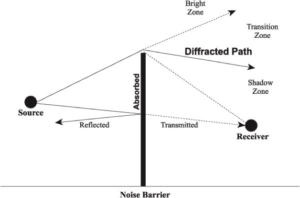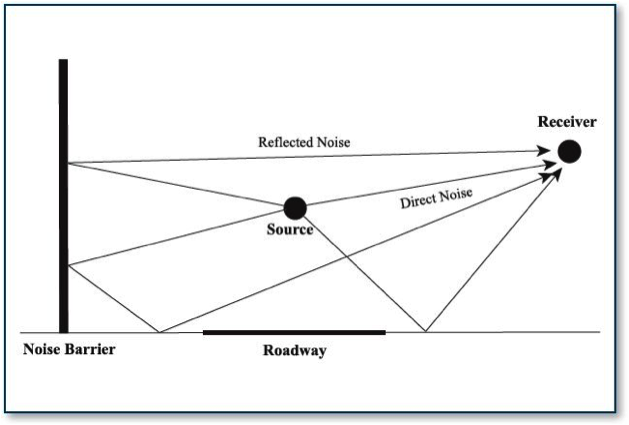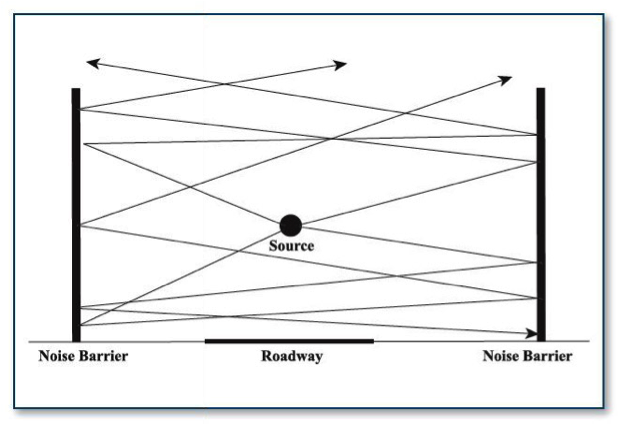 THE CASE FOR ABSORPTIVE SOUND WALLS IN THE TRANSPORTATION INDUSTRY
THE CASE FOR ABSORPTIVE SOUND WALLS IN THE TRANSPORTATION INDUSTRY
- The main purpose of this page is to undertake a state-of-the-art review of the technical aspects of the acoustical performance afforded by Sound Walls for various noise sources: road, rail, tunnels, and industrial complexes.
- This page will describe different types of barriers and focuses on the advantages of absorptive sound walls.
- This page is intended for educating the non-specialist as well as technical designers and engineers on the various aspects of absorptive and reflective sound walls and was created utilizing relevant industry articles from the National Precast Concrete Association (NPCA).
SUMMARY
Noise is an undesirable byproduct of our modern ways of life. Transportation noise is the most pervasive and difficult sound source to abate in society today. In an era of ever-widening highways, a concentrated effort is needed to control transportation noise using a system that is effective, durable and aesthetically pleasing. (1)
Numerous studies indicate that the most pervasive sources of noise today are those associated with transportation. Major sources of unwanted and destructive noise emissions originate from:
- Transportation equipment and facilities;
- Electrical machinery;
- Construction equipment; and
- Noise emitted by means of transport. (2)
Sound-sensitive receivers (typically places with people and-or animals who may be adversely impacted by loud noise) include residential homes or apartments, hospitals, schools, office buildings and nature areas. (2)
Sound walls are the most effective method of mitigating noise from major sources other than sound cessation or volume control at the source. (2)
There are two types of precast concrete sound walls: absorptive and reflective. When manufactured and installed properly, absorptive sound walls will almost always outperform and outlast systems consisting of competing materials such as brick, metal, concrete or wood. (3)
TO ABSORB OR TO REFLECT?
There are two types of sound walls: absorptive and reflective. Absorptive sound walls take in sound energy while reflective sound walls push sound energy back across the source (away from the receiver) and into the atmosphere. Both types of sound walls force sound waves to take a longer path – over and around the barriers – reducing the amount of sound reaching the receiver. This is known as diffraction (Figure 1). (1)

Figure 1: This diagram illustrates how diffraction affects sound.
Photo Courtesy of NPCA
After passing through an absorptive sound wall, lower amounts of sound energy remain to re-enter the environment, resulting in less noise reaching the ears of the receiver.
Materials and finishes used to manufacture absorptive precast concrete sound wall panels and posts vary, but can include:
- Sound-absorptive aggregates
- Lightweight cellular material
- Composite materials
- Acoustic facing tile
- Textured/stamped concrete surface, porous finish or stamped brick
- Fibrous materials (fiberglass, mineral wool, recycled tire rubber, or recycled wood fibers or shavings)
Unlike absorptive sound walls, reflective sound walls are not manufactured with absorptive materials or finishes. Instead, producers rely on the natural materials found in concrete to force sound back toward the source or into the atmosphere at a significantly decreased level. (1)
HOW SOUND WALLS WORK
Both types of Sound Walls (absorptive and reflective) help to force sound waves take a longer path (over and around the barriers) thereby reducing the amount of sound reaching the receiver; this is called diffraction. Diffraction occurs when sound waves pass an edge, such as wall edges and at the apex of the wall. Sound walls are more efficient at eliminating higher frequencies (shorter wavelengths) from reaching the receiver, since higher frequencies are diffracted at a smaller degree (angle) as compared with diffraction of lower frequencies (longer wavelengths). (2)
In general, a rule of thumb for sound barriers is that noise reduction falls into one of the following categories:

ABSORPTIVE WALLS ACT AS SOUND SPONGES
Absorptive sound walls allow for sound waves generated by the source to enter the wall structure. As the sound waves travel through the acoustical material or textured surface, they are forced to follow a longer path to the end source (forcing directional changes in the sound waves). Every directional change in the sound waves will decrease the waves’ energy. After passing through a sound-absorbing wall, very low amounts of sound energy remain to re-enter the environment; in this way, less noise reaches the receiver’s ears. (2)
Materials and finishes that are commonly used for manufacturing precast concrete absorptive sound wall panels and posts include:
- Textured/stamped concrete surface (double raked, popcorn or fuzzy finish); porous finish; or stamped brick
- Fibrous materials (fiberglass; mineral wool; recycled tire rubber; or recycled wood fibers or shavings)
- Sound-absorptive aggregates (perlite or vermiculite)
- Lightweight cellular material
- Acoustic facing tile
- Composite materials
Big players in sound absorption are the size and the shape of the path of the voids between the aggregate particles or admixtures added to the concrete mix. Fibrous materials produce some of the best results for sound absorption, as they are densely packed and randomly arranged in such a manner that makes a difficult path for the pressure wave in the air to be dissipated. (2)
The precast concrete absorptive wall manufacturer essentially strives to design an absorptive wall with a porous surface so that sound waves will enter the absorptive air-like surface and not be reflected by the wall’s surface. Sound traveling through a porous, absorptive material travels more slowly – about 70% of the speed that sound travels in open, non-obstructed air. In this way, porous materials increase low-end sound absorption. (2)
HOW SOUND-ABSORBING EFFECTIVENESS IS MEASURED
The Noise Reduction Coefficient (NRC) [NRC: Noise Reduction Coefficient] determines the amount of energy reflected back toward the noise source and the amount of energy absorbed by the wall material. NRC ratings will have a range between 0 (100% reflective) to 1 (100% absorptive). A precast concrete sound wall with a rating of 0.7 means that the wall absorbs 70% of the noise and deflects 30% of the noise back toward the source. A typical NRC for an absorptive sound wall ranges from 0.6 to 0.9. (3)
The Sound Transmission Class (STC) determines the amount of noise energy that is ultimately transmitted through the wall material and the noise energy that reaches the receiver. Sound walls that have a STC rating of 30 or more represent walls in which less than 0.1% of the noise energy is transmitted through the barrier material. Many state DOT specifications require a minimum STC rating of 24. (3)
Absorptive sound wall surfaces avoid the negative effects that may occur with reflective sound wall surfaces. Reflected sound waves may pose a problem, as it is difficult to precisely predict the path of the reflected sound waves. Once a sound wave is reflected from a flat surface, numerous variables can affect the direction of the diffracted sound wave. Therefore, sound absorptive walls are less likely to produce uncontrollable and unexpected results. (3)

Reflective Diagram #1
Photo Credit: National Precast Concrete Association

Reflective Diagram #2
Photo Credit: National Precast Concrete Association
ABSORPTIVE SOUND WALLS
Absorptive Sound Walls enable sound waves generated by the traffic or other noise sources to enter the absorptive wall treatment. As sound waves travel through the acoustical material or textured surface, they are forced to follow a longer path to the end source (forcing directional changes in the sound waves). (3)
Every directional change in the sound wave will decrease the energy of the wave. After passing through a sound-absorbing wall, lower amounts of sound energy remain to re-enter the environment, resulting in less noise reaching the ears of the receiver. (3)
The degree of sound absorption is affected by the size and shape of the path of voids between the aggregate particles or admixtures included in the concrete mix. Fibrous materials produce some of the best results for sound absorption because they are densely packed and randomly arranged in a manner that makes a difficult path for the pressure wave in the air to be dissipated. (3)
Precast concrete absorptive wall manufacturers typically design absorptive walls with porous surfaces so that sound waves will enter the absorptive air-like surface rather than be reflected by the wall’s surface. Sound traveling through a porous, absorptive material travels at about 70% of the speed that sound travels in open, non-obstructed air. In this way, porous materials increase low-end sound absorption. (3)
There are many designs and variances of sound barrier wall design, material and construction. As with any other building material, the cost and benefits must be considered. The use of acoustical absorptive sound barriers is a cost effective solution where reverberant and reflective sound reduction is needed to maximize overall noise mitigation. (3)
SOURCES
(1) Goguen, Claude, P.E., A Sound Decision, Home / Precast Magazines / Precast Solutions Magazine / 2014 – Summer, Available at: http://precast.org/2014/07/sound-decision/
(2) Gurley, Evan, Quiet Please!, Home / Precast Magazines / Precast Solutions Magazine / 2011 – Winter, Available at: http://precast.org/2011/02/quiet-please-2/
(3) Precast Concrete Absorptive Sound Walls Technical Brochure, National Precast Concrete Association, Available at: http://precast.org/wp-content/uploads/2014/08/Absorptive-precast-concrete-soundwall-brochure-edited.pdf
